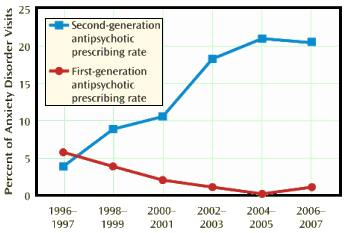![]()
Occam’s razor, also known as Ockham’s razor, and sometimes expressed in Latin as lex parsimoniae [the law of parsimony, economy or succinctness], is a principle that generally recommends selecting from among competing hypotheses the one that makes the fewest new assumptions.
National Trends in the Antipsychotic Treatment of Psychiatric Outpatients With Anxiety Disorders
by Jonathan S. Comer, Ramin Mojtabai, and Mark Olfson
American Journal of Psychiatry 2011 168:1057-1065.Conclusions: Although little is known about their effectiveness for anxiety disorders, antipsychotic medications are becoming increasingly prescribed to psychiatric outpatients with these disorders.
Dr. Breier’s stealth aside, there’s a much simpler explanation for Dr. Comer’s findings of a dramatic increase in the use of Atypical Antipsychotics to treat Anxiety, requiring no further research. The simplest version of the wisdom of Occam’s Razor is: The simplest explanation is usually right. So my answer to the question, "Why are psychiatrists giving Atypical Antipsychotics to people with Anxiety Disorders?" takes only 9 words. "In Modern Times, they are the only available option."
| Modern Times |
|
|
|
• DSM-III, DSM-III R, DSM-IV, DSM-IV TR:
Prior to the DSM-III in 1980, Anxiety was a symptom – fear from an unknown cause – following the psychoanalytic idea that Anxiety was a felt signal of danger. With the coming of the new classification, excessive Anxiety became a Disorder – the problem itself rather than a symptom of the problem. My own take on this change is that this is an area where the DSM revisions were helpful in focusing our attention on those patients whose anxiety transcends their life situation or internal life. The downside of the revision is that it only fits some patients. There are plenty of people whose Anxiety is a symptom of something else – real or imagined.
• Managed Care:
In the 1980s, in response to the general feeling that psychotherapy was being over-used and that Psychiatrists specifically were too expensive, there was a radical change in mental health initiated by the third party carriers. The net result was that covered psychiatric visits were limited in length and number, with reimbursed psychotherapy partitioned to other specialties on a limited basis. The net result was that psychiatrists see patients for brief diagnostic evaluations and medication treatment. That is the current standard of practice.
• Addiction to Benzodiazepines:
The first-line effective pharmaceutical treatment of anxiety are the Benzodiazepines. They are both psychologically and physically addicting. Used long term, tolerance develops and the dose requirement escalates. Standard practice these days is to reserve their use for short term situations and avoid them as maintenance for anxious patients.
|

Sorry, the comment form is closed at this time.